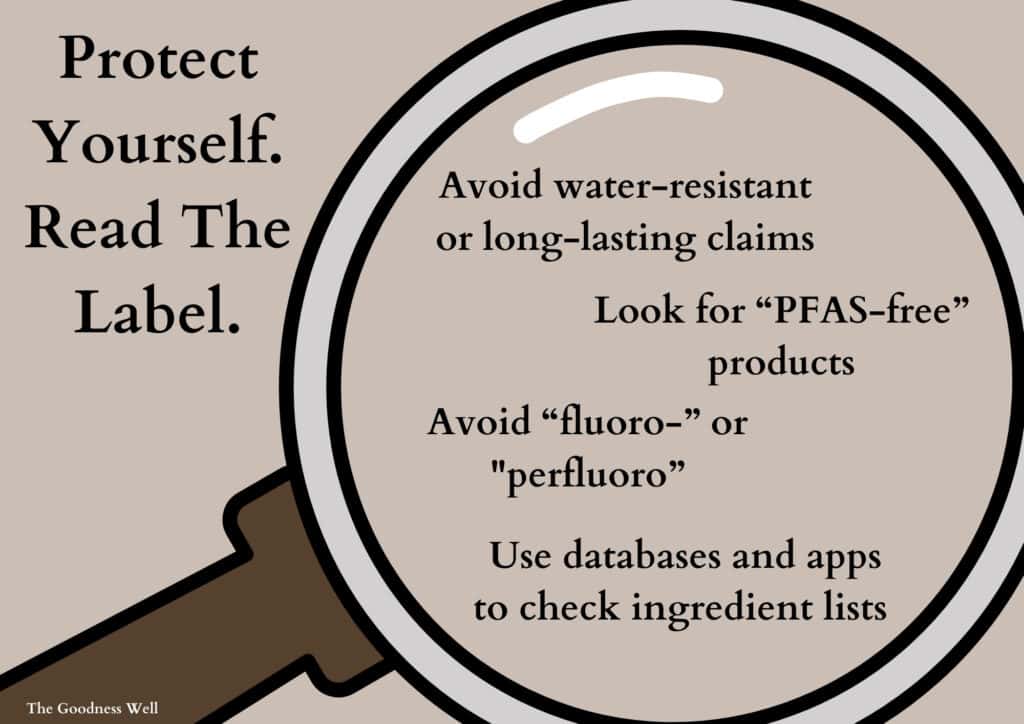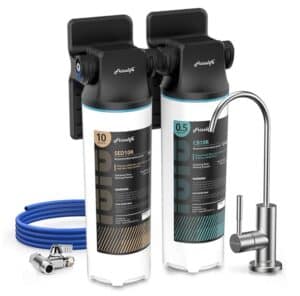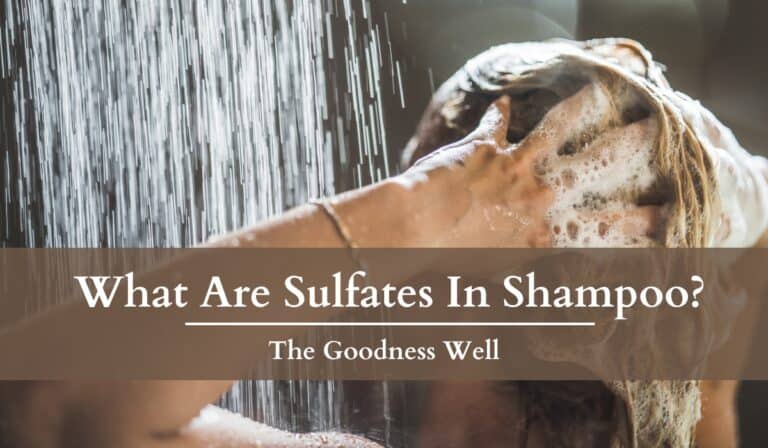How To Avoid PFAS (5 Actionable Steps To Take ASAP)

Wondering how to avoid PFAS? We don’t blame you.
If you’ve heard of these “forever chemicals“, you might be wondering how to avoid them.
Well, we’ve done a lot of research and come up with some easy tips and tricks we’ve implemented in our own lives to help reduce our exposure to these nasty chemicals.
TL;DR
How to Reduce Exposure to PFAS:
- Filter Your Water: Use NSF 53 or 58 certified activated carbon or reverse osmosis filters.
- Smarter Food Choices: Store in glassware, limit seafood, avoid convenient packaging
- Switch Cookware: Switch to non-toxic options like cast iron, ceramic, or stainless steel.
- Read Cosmetic Labels: Avoid products with “fluoro-” ingredients and use databases like EWG for safety checks.
- Avoid Certain Clothing: Be cautious with water-resistant or stain-resistant clothing, research brands for non-toxic options.
We are reader-supported. So some links in this post may be affiliate links, which means we may earn a small commission if you make a purchase. Learn more
How to Avoid PFAS
The abundance of PFAS in our products and environment makes it hard to completely avoid them but here are some steps you can take to limit your exposure.
1. Filter Your Water
PFAS can be found in both tap water (with at least 45% of US tap water containing PFAS) and bottled water.
Filtering Home Water
- Water Filters Proven to Remove PFAS: Activated carbon or reverse osmosis certified by the National Sanitation Foundation (NSF)
- NSF/ANSI 53 certification for filters
- NSF/ANSI 58 for reverse osmosis systems.
- Types of Water Filters For Home:
- Pitcher Filter: The cheapest and easiest option to filter smaller amounts of water but less cost-effective over time.
- Refrigerator Filters: Easy to install filters for specific refrigerators. Must search google for your specific refrigerator + NSF 53 filter.
- Under-Sink Carbon Filters: Activated carbon filters installed under the sink. Installation is moderately easy.
- Reverse Osmosis Systems: Complex installation but best filtration and most cost-effective.
- Single Sink Systems: Typically cost a few hundred dollars. Best for individual sinks.
- Whole Home Systems: Best filtration option but expect to spend 1k or more with advanced setup.
Many water filtration companies use loose terminology like “tests to NSF standards” but are not actually NSF-certified. Purchase only NSF certified 53 or 58 filters.
Our Water Filter Recommendations
Water Pitcher Filter (fits Brita only)
- Cost: $45
- Cheaper initially but less cost-effective over time
- Installation: Easy
- Filtration: Very Good
- Certified NSF 53
Single Under-Sink Carbon Filter (the one we use):
- Cost Avg: $70-$150
- Installation: Easy-Moderate
- Filtration: Very Good
- Certified NSF 53
- Note: DW10F comes with an extra faucet which is recommended but involves extra steps to install. DW10 allows you to hook up to your current faucet.
We use the DW10F filter as you can see in the picture below. The installation was pretty straightforward and took about 30 minutes (not 5 minutes like the website says). The water tastes great, too! No complaints here. In the future, we will probably upgrade to a reverse osmosis system.

Refrigerator Filters:
Filter varies depending on refrigerator model and manufacturer. Search the web for your specific refrigerator and pick a filter that is NSF 53 certified
Single Under-Sink Reverse Osmosis Systems:
- Cost Avg: $200+
- Most cost-effective over time
- Installation: Complex
- Filtration: Best
- Certified NSF 58
*Higher-end/more expensive options usually have longer filter life and added filter capabilities
Bottled Water
We recommend avoiding bottled water for a few reasons:
- It’s a single-use plastic that contributes to waste
- PFAS have been found in water bottles
- The FDA (who regulates bottled water) hasn’t established standards to limit PFAS in water bottles
- Water bottles contain thousands of microplastics that are small enough to enter our bloodstream and organs like our heart and brain
The study above does state, “Purified water products contained significantly less PFAS than Spring water products”.
So, if you must drink bottled water, choose purified over spring water.
Using a plastic-free, reusable water bottle filled with water from an NSF 53 or 58 certified water filter at home is the best option to avoid PFAS in water.
Here is the same water bottle we use (made of glass with a silicone protective sleeve)
2. Avoid PFAS Food Sources
Here are some practical tips to help you minimize contact with these harmful chemicals in your meals

- Use Glassware: Store food in glass containers. They are less likely to contain PFAS and other chemicals than plastic ones.
- Limit Seafood & Fish: The FDA did a study in 2022 that found PFAS in 74% of seafood tested. Pick farm-raised seafood as it likely has less PFAS than any fish caught in a lake or ocean.
- Avoid Convenient Packaging: Any type of packaging or food wrap that is oil-resistant is a big no-no. Heating food packaging is even worse! It will speed up the release of these chemicals.
- Avoid Microwave Popcorn: The oil-resistant packaging usually has PFAS in it. Instead of buying pre-packaged microwave popcorn, get loose popcorn kernels and pop them on the stove.
- Eat Fresh: The best way to sidestep PFAS in food is by consuming fresh, unpackaged foods. Focus on:
- Fruits
- Vegetables
- Healthy fats
- Lean meats
3. Switch Cookware
PFAS, especially common versions like PTFE or PFOA, have been common in non-stick cookware options for years.
Manufacturers may have switched to “GenX” as a replacement, but this “regrettable substitute” is just as toxic as the others.

To sidestep these risks, consider switching to safer, non-toxic cookware options such as:
- Cast Iron
- Ceramic
- Stainless Steel
- Glass
Also, get rid of any old cookware with cracks or chips that can release these harmful chemicals into your food.
Check with your local area on their protocols for recycling cookware.
4. Read Cosmetic Labels
Read those labels! – Something we constantly preach here at The Goodness Well.
No matter what claims a company makes on the front of their product, the ingredients will always show who’s really who.
Here’s how you can be proactive in ensuring your cosmetics are safe:

- Avoid certain product claims: If a product claims it’s water-resistant or long-lasting, be on alert. These features might be due to PFAS-related ingredients.
- Check the ingredients list: Any terms that include “fluoro-” or “perfluoro” are a no-no. If you see these, there’s a good chance it has PFAS.
- Brand transparency: Many responsible brands are upfront about their ingredients and commitment to health. Always visit a brand’s website to look for statements regarding PFAS-free products.
- Use reliable databases: The Environmental Working Group (EWG) offers a database for personal-care products. You can search any product or brand and get a detailed view of the actual safety of the product.
- Leverage technology: Download Clearya. It’s a free mobile app and browser extension that shows you unsafe chemicals, including PFAS, in products while you’re shopping online (only at certain stores). It even offers non-toxic alternatives!
We used to use apps like Clearya but have gotten pretty good over time at spotting those toxic products and brands over time without needing to scan ingredient lists.
Over time you’ll be able to do the same!
5. Avoid Certain Clothing & Other Products
Clothing that’s water-resistant or stain-resistant usually has PFAS. Use the following steps to limit your exposure:
- Be Cautious of Specific Products: Outdoor gear, athletic wear, and water-resistant jackets are often treated with PFAS for better performance. Choose non toxic options for this kind of clothing. Even sleeping bags can be treated with these chemicals as well so be sure you choose organic, eco friendly options instead.
- Research Brands: Check out the brand’s official website. If they are PFAS-free or non-toxic, they’re usually pretty vocal about it on their website.
- Ask Directly: If you’re unsure about a brand’s use of PFAS or any other chemicals, don’t hesitate to contact their customer service. Brands that prioritize consumer health will typically be transparent about their practices.
Final Thoughts
Truth is, completely avoiding PFAS is almost impossible as they are everywhere.
However, with the tips we listed above, you’ll be able to reduce your exposure by a lot.
At The Goodness Well, we’re always researching (and implementing in our own lives) ways to reduce our exposure to harmful chemicals.
We’ll continue to update this article with the most helpful information as we continue to learn. Thanks for reading!
Check out some of our other posts below!









